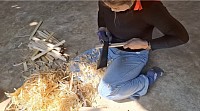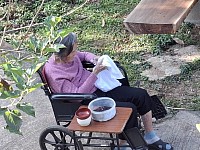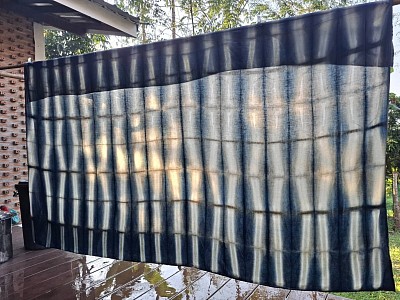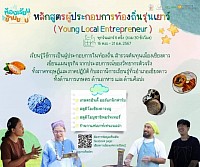Siripohn's Insights (Blog)
A look back at the impactful reunion of the Makhampom Art Space community,
A look back at the impactful reunion of the Makhampom Art Space community, where we continued our commitment to Active Learning—empowering facilitators, educators, and artisans with holistic learning methodologies. This long-standing initiative has provided invaluable knowledge to teachers, students (both within and beyond formal education systems), as well as professionals in the fields of crafts and education, fostering a transformative approach to learning that keeps pace with the evolving demands of society and the modern world.
By equipping learners—both in and outside traditional education systems—with the necessary skills, techniques, and the freedom to shape their own paths, this initiative ultimately cultivates sustainable personal growth from within.
As one of the learning stations in this project, Chiangdao Blue strongly believes that natural indigo dyeing can serve as a meaningful pathway for nurturing young artisans. By mastering and applying this traditional craft, they can establish sustainable careers while preserving and carrying forward Thailand’s rich cultural heritage in craftsmanship.
Bamboo Sticks for Ita-Jime (Clamping) Pattern Making: A Sustainable Approach
The concept of sustainability is vast and multifaceted. At Chiangdao Blue, we embrace sustainability by prioritizing the use of locally sourced materials and exploring simple, traditional technologies. Our goal is to be as self-reliant as possible, minimizing external dependencies while maximizing the resources available in our surroundings.
This approach allows us to enjoy the process—a journey that deepens our connection with both our craft and the natural world. It fosters inner strength, cultivates a profound respect for nature, and instills a sense of pride in our work. By integrating sustainability into every step, we not only preserve traditional wisdom but also create meaningful and enduring art.
Life Lessons from My 90-Year-Old Mother
Despite her age and occasional struggles with emotional regulation due to dementia, my 90-year-old mother lives each day with intention, value, and meaning. She remains active, possesses a sharp memory, and constantly seeks to engage in productive work. Her current daily task is creating shibori patterns on high-quality cotton fabric in the "Furoshiki" style, measuring 70x70 cm. These fabric wraps serve as eco-friendly packaging for customers who purchase clothing from our shop, reducing waste from disposable packaging. Customers can later repurpose the Furoshiki as a bandana or in any other way they find useful.
Caring for the elderly in Thailand has increasingly become a challenge for children and families—a social issue that requires thoughtful attention. It is crucial for children to prioritize their aging parents' wellness and ensure they receive the close care they need. By centering our approach around our parents’ well-being, we can design a lifestyle that works for both them and ourselves. When we truly focus on this, we realize that we have more options than we initially thought. In fact, through this journey, we often discover new perspectives on life for ourselves as well.
One fundamental truth is that parents in their 80s and 90s have endured immense hardships for the sake of their children. Ensuring their happiness and wellness in their final years is not just an act of gratitude—it is a meaningful gift that strengthens our own hearts in ways we never expected.
Homegrown, Homemade Indigo Paste: A Captivating Choice for Artistic Expression
Extracted from the indigo plant, homegrown, homemade indigo paste offers an intriguing alternative for painting, evoking the aesthetic mood of traditional Chinese ink paintings in monochrome—only this time, in the mesmerizing blue-and-white palette of natural indigo. This enchanting blue hue, derived from a medicinal plant, carries a unique charm. Remarkably, the pigment extracted from indigo leaves isn’t limited to the iconic blue; hidden within are other shades, including yellow from flavonoids, red from indiburin, and brown tones. These pigments, with their medicinal properties, make indigo a truly remarkable natural gift.
Historically, indigo’s medicinal benefits extended beyond its use as a dye. In the absence of modern medicine, local communities relied on the plant for healing purposes. For instance, crushed indigo leaves mixed with a pinch of sea salt were wrapped in cloth and applied to insect bites. Similarly, these crushed leaves were used to reduce fever in children. The pigment, with its anti-bacterial and UV-protective qualities, embodies both beauty and functionality.
The timeless allure and medicinal properties of indigo deserve a place in modern life, adapted thoughtfully to fit our digital age. Beyond its physical benefits, this natural gift offers intangible rewards—instilling warmth, gratitude, and a sense of interconnectedness with nature. By embracing such treasures, we nurture a deeper appreciation for the delicate balance of our environment and the importance of its preservation. Let indigo, a legacy from nature, inspire both creativity and mindfulness in our daily lives.
Introducing our Extra-Large Tote Bag
Introducing our Extra-Large Tote Bag, crafted from handwoven Saki-Ori fabric—a traditional Japanese weaving technique rooted in the "Zero Waste" philosophy. The weft threads are made by repurposing fabric scraps or worn-out garments, such as old or torn clothing, which are cut diagonally into strips and woven into the fabric. The result is a thick, textured material that’s perfect for creating simple yet stylish bags or versatile home textiles like table runners or tapestries.
Each tote bag is truly one-of-a-kind, as no two pieces of Saki-Ori fabric are ever the same. Remarkably, one piece of woven fabric is used to make just a single tote bag, ensuring its unique charm and exclusivity.
Studio Chiangdao Blue is a natural dye studio
Studio Chiangdao Blue is a natural dye studio rooted in the principles of self-reliance and sustainability. Our focus lies in utilizing local materials and traditional wisdom, blended with appropriate technologies, to protect the environment while sharing knowledge about natural indigo and plant-based dyes with children, youth, and anyone with an interest.
We position our space as an open learning station and creative workspace, welcoming everyone. Collaboration and mutual learning are at the heart of what we do. We seek partnerships with like-minded individuals and organizations and are committed to exploring new possibilities, showcasing the potential of indigo beyond textiles, experimenting with various materials, and pushing creative boundaries.
Our philosophy emphasizes continuous growth—both in skills and in nurturing a mindful, ethical, and spirited approach to our craft. Together, we strive to unlock the full potential of natural dyes, inspiring innovation and sustainability for generations to come.
Let's Upcycle !!!
Many of us have wardrobes overflowing with clothes, both old and new, yet we rarely wear them all. If you think about it, you might realize that less than 50% of the clothes you own are worn regularly. The rest simply sit untouched in your closet. Among these, there are often pieces we still like but no longer wear due to stains—perhaps from tea, coffee, or chili sauce—or because their colors have faded. These beloved yet unused clothes can be given a new life through dyeing. With some creativity and effort, they can transform into soft, comfortable, and uniquely patterned garments that you’ll love to wear again—all while enjoying the process of designing and dyeing them yourself.
In the end, you’ll have a beautifully refreshed piece that you’ve created with your own hands. It’s a joyful experience, not just for you, but for the garment itself—it gets a second chance rather than being discarded as waste.
Today, we gave an old, stained bedsheet a new lease on life by dyeing it with ebony berry and indigo. This repurposed bedsheet could now be turned into pants, shirts, or even pajamas.
I’d like to invite everyone who’s interested to join us in the journey of upcycling and discovering the joy of breathing new life into old fabrics!
He natural dye process
Preparing Lac Insect Nests for Cultivation
Before placing lac insects onto trees for cultivation, it is essential to prepare well-constructed nests that house a thriving colony of insects. The process begins by taking about two handfuls of dry rice straw and dividing it into two equal portions. Lay the straw in two overlapping rows, aligning the ends so they connect seamlessly. Next, use a string made from bamboo skin to bind the straw together, forming a single, continuous strand.
Once the straw is secured, insert a lac nest about 10 cm long into the straw, ensuring there’s enough straw left at the ends to fold over and fully cover the lac nest. Bind the straw firmly with the bamboo string to secure the nest inside. Repeat this process on both the left and right ends of the straw.
After both ends are prepared, lift the straw bundle and bend it at the center to form a 90-degree angle. This shape allows the nest to be easily attached to tree branches for cultivation.
Notably, all materials used in preparing these lac nests come from nature—whether it’s the rice straw or the bamboo string. These materials are environmentally friendly and leave no waste behind, reflecting the sustainable practices of our ancestors. This traditional wisdom is truly admirable, demonstrating a deep respect for nature and the ecosystem.
Lac Dye for Pink to Red Fabric Tones
Today, I had the opportunity to learn about the preparation of lac cultivation on trees with the Chiangdao Learning Station network at Kala Garden, owned by Khun Ek, located not far from Chiangdao Blue. The lac insects will begin to be nurtured on trees in December during the winter season and will remain for a full year.
The pink to red hues derived from lac are produced from a resin-like substance released by the insects as they build their nests. This resin offers remarkable versatility. Beyond its use in dyeing fabrics, the red pigment from lac is widely utilized in the pharmaceutical, food, and cosmetics industries, as well as for producing shellac.
Though the lac insect is tiny, almost resembling a mite, the vibrant red resin it creates is nothing short of extraordinary, offering a wide array of incredible benefits.
Tataki-zome on Cotton-Linen Fabric Using Fresh Leaves of Local Assam Indigo
This piece showcases the tataki-zome (pounding) technique on a cotton-linen blend fabric using fresh leaves from two varieties of local Assam indigo. The first variety, with larger leaves, is commonly found in the mountainous regions of northern Thailand, while the second, smaller-leafed variety comes from Phrae province and is rarely encountered.
The uniqueness of Assam indigo lies in its status as an indigo-bearing plant native to specific environments. It thrives in shaded, cool, and humid conditions. Prolonged exposure to intense sunlight can cause the leaves to turn yellow, adversely affecting the quality of the indigo dye they produce. In the accompanying image, the upper leaves represent the larger-leafed variety, while the lower ones belong to the smaller-leafed variety.
A distinctive feature of Assam indigo is its thick leaves, which contain a high percentage of indigo pigment. Unlike other indigo-bearing plants, the indigo pigment is found not only in the leaves but also in the stems and branches. Historically, before the widespread availability of Western medicine, local communities used fresh Assam indigo leaves as herbal remedies to reduce fevers and counteract the effects of insect or snake bites.
Today, such traditional uses are nearly forgotten, as modern medicines are more accessible and convenient. However, the indigenous knowledge surrounding Assam indigo, both as a medicinal plant and as a source of natural dye, remains a cultural heritage of great value. It is a legacy worth preserving and building upon for future generations.
A Creative Exchange at Studio Chiangdao Blue
Today, I had the opportunity to engage in an insightful conversation with a graphic designer from Germany. We found common ground in discussing the role of technology in the digital age. With applications designed for nearly every industry, technology has undeniably made work more efficient, streamlined, and faster. It solves problems, reduces obstacles, and enhances productivity.
However, as human beings, there's another essential aspect that must run parallel to technology: art and traditional craftsmanship. These skills, rooted in ancient wisdom, reflect the essence of humanity. They serve as a reminder of our cultural identities, diverse backgrounds, and unique heritage, offering a profound sense of pride and belonging.
In a world where many young people work closely with technology daily, it's important to seek opportunities to engage with traditional crafts. This not only helps in preserving these invaluable skills but also provides a balance for the mind and spirit, fostering a sense of stability and connection to one's roots.
I've found great joy and inspiration in connecting with individuals from various countries who come together here at Studio Chiangdao Blue. It's more than just a space for natural indigo dyeing workshops. It's a place where we exchange ideas and learn from one another, weaving together life's many stories through the lens of natural indigo.
I'm grateful that Studio Chiangdao Blue offers such an atmosphere—a place that welcomes and nurtures meaningful connections.
Creative Tourism Experience
Yesterday, after a mother and son finished their indigo dyeing workshop, the mother asked to take a photo with my 90-year-old mother before leaving. Perhaps it was because, during the workshop, my mother had expressed her heartfelt gratitude to them for making the effort to rent a car and travel all the way from Chiang Mai city—a three-hour round trip.
Throughout the 3-4 hours of the workshop, my mother was also busy creating her own shibori patterns. Despite the language barrier, she tried to engage with the guests in Thai, and they could feel her genuine warmth and hospitality. After showcasing her unique, original shibori designs, the son was inspired to incorporate elements of her patterns into his own T-shirt design.
The atmosphere was cozy, relaxed, and full of meaningful connections. We had participants spanning four generations—from a 10-year-old to individuals in their 30s, 40s, 60s, and my 90-year-old mother.
If you’re someone who loves crafts, I invite you to come and experience this unique environment. You'll leave feeling energized and uplifted, with a deep sense of connection to others. It’s truly a heartwarming experience that stays with you.
Natural Indigo Dyeing: A Memorable Experience for You and Your Loved Ones
Indulging in natural indigo dyeing is a wonderfully enriching activity, perfect for creating lasting memories. Not only does it offer a new and exciting experience, but it also encourages creativity, hands-on learning, and allows you to craft unique, practical pieces with your own two hands.
Just the other day, our neighbor, “Khun Pla,” a healing therapist and instructor, joined us to celebrate her birthday with a personal indigo dyeing project. She dyed a large shawl and bandana using the Ita-Jime technique and even revitalized a favorite old shirt with a fresh indigo shade.
In a similar spirit, a couple from the U.S. recently chose to mark their 50th wedding anniversary by immersing themselves in creative activities during their trip to Chiang Mai. One highlight of their celebration was exploring the art of indigo dyeing with us.
For special occasions, whether for yourself or with loved ones, activities like these offer meaningful ways to connect and create cherished keepsakes that hold both beauty and sentiment.
"Young Local Entrepreneur" program
"Young Local Entrepreneur" program:: Studio Chiangdao Blue, as a learning station in the whole learning project organized by Makampom Art Space, is holding an engaging activity for local children and youth through an experiential learning project focused on sustainability. This hands-on learning experience introduces participants to the art of natural indigo dyeing under the concept "From Seed to Dye," a journey that Chiangdao Blue has been cultivating.
In a previous workshop, children explored the dye studio, learning about planting, color extraction, dye vat creation, and the process of designing and dyeing fabric with indigo. They experienced the full cycle of indigo's journey from nature to fabric, and with their hands-on creations, they gained a deep appreciation for the craftsmanship and wisdom rooted in traditional arts.
This time, we're excited to step up with a new activity, “Young Local Entrepreneur,” designed for local youth aged 15 and up. Beyond learning the dyeing process, students will now be encouraged to question, explore, and brainstorm ways to transform these skills into income-generating activities. Just reading about it sparks interest, excitement, and the thrill of new challenges.
As a part of the Chiang Dao community, Studio Chiangdao Blue constantly reflects on how we can give back to our community, especially to students and youth in their formative years. We aspire to provide a diverse skill set and inspire young people to discover their passions and strengths. Through this journey, they can gradually gain a clearer vision of their future and shape a path they have helped design themselves.















